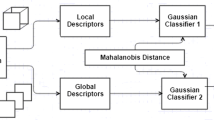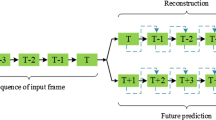Abstract
Because of ambiguous definition of anomaly and the complexity of real data, anomaly detection in videos is of utmost importance in intelligent video surveillance. We approach this problem by learning a novel 3D convolution autoencoder architecture to capture informative spatiotemporal representation, and an 2D convolutional autoencoder to learn the pixel-wise correspondences of appearance and motion information to boost the performance. Experiments on some publicly available datasets demonstrate the effectiveness and competitive performance of our method on anomaly detection in videos.
Supported by Wuhan University.
Access this chapter
Tax calculation will be finalised at checkout
Purchases are for personal use only
Similar content being viewed by others
References
Dalal, N., Triggs, B.: Histograms of oriented gradients for human detection. In: IEEE Computer Society Conference on Computer Vision and Pattern Recognition, CVPR 2005, vol. 1, pp. 886–893. IEEE (2005)
Dalal, N., Triggs, B., Schmid, C.: Human detection using oriented histograms of flow and appearance. In: Leonardis, A., Bischof, H., Pinz, A. (eds.) ECCV 2006. LNCS, vol. 3952, pp. 428–441. Springer, Heidelberg (2006). https://doi.org/10.1007/11744047_33
Goroshin, R., Bruna, J., Tompson, J., Eigen, D., LeCun, Y.: Unsupervised feature learning from temporal data. arXiv preprint arXiv:1504.02518 (2015)
Hasan, M., Choi, J., Neumann, J., Roy-Chowdhury, A.K., Davis, L.S.: Learning temporal regularity in video sequences. In: Proceedings of the IEEE Conference on Computer Vision and Pattern Recognition, pp. 733–742 (2016)
Hinton, G.E., Salakhutdinov, R.R.: Reducing the dimensionality of data with neural networks. Science 313(5786), 504–507 (2006)
Li, Y., Liu, W., Huang, Q.: Traffic anomaly detection based on image descriptor in videos. Multimed. Tools Appl. 75(5), 2487–2505 (2016)
Lu, C., Shi, J., Jia, J.: Abnormal event detection at 150 FPS in MATLAB. In: Proceedings of the IEEE International Conference on Computer Vision, pp. 2720–2727 (2013)
Mahadevan, V., Li, W., Bhalodia, V., Vasconcelos, N.: Anomaly detection in crowded scenes. In: 2010 IEEE Conference on Computer Vision and Pattern Recognition (CVPR), pp. 1975–1981. IEEE (2010)
Masci, J., Meier, U., Cireşan, D., Schmidhuber, J.: Stacked convolutional auto-encoders for hierarchical feature extraction. In: Honkela, T., Duch, W., Girolami, M., Kaski, S. (eds.) ICANN 2011. LNCS, vol. 6791, pp. 52–59. Springer, Heidelberg (2011). https://doi.org/10.1007/978-3-642-21735-7_7
Poultney, C., Chopra, S., Cun, Y.L., et al.: Efficient learning of sparse representations with an energy-based model. In: Advances in Neural Information Processing Systems, pp. 1137–1144 (2007)
Ramanathan, V., Tang, K., Mori, G., Fei-Fei, L.: Learning temporal embeddings for complex video analysis. In: Proceedings of the IEEE International Conference on Computer Vision, pp. 4471–4479 (2015)
Rifai, S., Vincent, P., Muller, X., Glorot, X., Bengio, Y.: Contractive auto-encoders: explicit invariance during feature extraction. In: Proceedings of the 28th International Conference on International Conference on Machine Learning, pp. 833–840. Omnipress (2011)
Srivastava, N., Mansimov, E., Salakhudinov, R.: Unsupervised learning of video representations using LSTMs. In: International Conference on Machine Learning, pp. 843–852 (2015)
Stewart, R., Ermon, S.: Label-free supervision of neural networks with physics and domain knowledge. In: AAAI, vol. 1, pp. 1–7 (2017)
Tran, D., Bourdev, L., Fergus, R., Torresani, L., Paluri, M.: Learning spatiotemporal features with 3d convolutional networks. In: Proceedings of the IEEE International Conference on Computer Vision, pp. 4489–4497 (2015)
Tung, F., Zelek, J.S., Clausi, D.A.: Goal-based trajectory analysis for unusual behaviour detection in intelligent surveillance. Image Vis. Comput. 29(4), 230–240 (2011)
Vincent, P., Larochelle, H., Bengio, Y., Manzagol, P.-A.: Extracting and composing robust features with denoising autoencoders. In: Proceedings of the 25th International Conference on Machine Learning, pp. 1096–1103. ACM (2008)
Dan, X., Yan, Y., Ricci, E., Sebe, N.: Detecting anomalous events in videos by learning deep representations of appearance and motion. Comput. Vis. Image Underst. 156, 117–127 (2017)
Acknowledgment
The work is supported by the funding CXFW-18-413100063 of Wuhan University. It is also supported by the Huawei-Wuhan University Funding (No. 250000916) and the National Key Research and Development Program of China (No. 2018YFB1600600).
Author information
Authors and Affiliations
Corresponding author
Editor information
Editors and Affiliations
Rights and permissions
Copyright information
© 2020 Springer Nature Singapore Pte Ltd.
About this paper
Cite this paper
Chang, Y., Tu, Z., Luo, B., Qin, Q. (2020). Learning Spatiotemporal Representation Based on 3D Autoencoder for Anomaly Detection. In: Cree, M., Huang, F., Yuan, J., Yan, W. (eds) Pattern Recognition. ACPR 2019. Communications in Computer and Information Science, vol 1180. Springer, Singapore. https://doi.org/10.1007/978-981-15-3651-9_17
Download citation
DOI: https://doi.org/10.1007/978-981-15-3651-9_17
Published:
Publisher Name: Springer, Singapore
Print ISBN: 978-981-15-3650-2
Online ISBN: 978-981-15-3651-9
eBook Packages: Computer ScienceComputer Science (R0)




